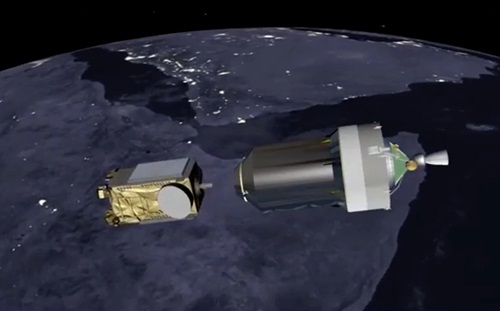Indian Space Research Organisation (Isro) today successfully placed its heaviest and most-advanced high throughput communication satellite GSAT-11 from the Spaceport in French Guiana during the early hours today.
The GSAT-11 satellite, also called the "Big Bird" was successfully launched into space around 2.07 am (IST) from the French space port of Kourou in South America, using an Ariane 5 rocket.
The satellite, weighing 5,854 kg, is the heaviest India-made equipment that Isro has so far put into orbit.
The satellite will help provide satellite-based internet to remote places where cable-based internet cannot reach.
Today’s launch was the second attempt after Isro's failed bid in May this year. The GSAT 11 was placed into space by the Ariane 5 rocket on its 102nd flight.
Isro said the satellite is in full health after the launch.
The launch vehicle Ariane 5 VA-246 lifted off from Kourou Launch Base, French Guiana at 02:07 am (IST) carrying India’s GSAT-11 and South Korea’s GEO-KOMPSAT-2A satellites, as scheduled. Ariane 5 is one of three launch vehicles operated by Arianespace along with Soyuz and Vega.
After a 30-min flight, GSAT-11 separated from the Ariane 5 upper stage in an elliptical geosynchronous transfer orbit. The achieved orbit was very close to the intended one.
The 5,854-kg GSAT-11 will provide high data rate connectivity to users of Indian mainland and islands through 32 user beams in Ku-band and 8 hub beams in Ka-band.
“GSAT-11 will boost the broadband connectivity to rural and inaccessible gram panchayats in the country coming under the Bharat Net Project, which is part of Digital India Programme,” ISRO chairman K Sivan said.
The Bharat Net Project aims to enhance the public welfare schemes like e-banking, e-health, e-governance among others.
He said GSAT-11 will act as a forerunner to all future high throughput communication satellites. “Today’s successful mission has boosted the confidence of the entire team,” Sivan added.
Post-separation, Isro's Master Control Facility at Hassan in Karnataka took over the command and control of GSAT-11 and found its health parameters normal.
The scientists will undertake phase-wise orbit-raising manoeuvres in the days ahead to place the satellite in the geostationary orbit (36,000 km above the equator) using its on-board propulsion systems. GSAT-11 will be positioned at 74-degree east longitude in the geostationary orbit.
Subsequently, the two solar arrays and four antenna reflectors of GSAT-11 will be deployed in orbit. The satellite will be operational after the successful completion of all in-orbit tests.
In the last 21 days, Isro successfully completed three satellite and two launch vehicle missions.














.jpg)






.jpg)









